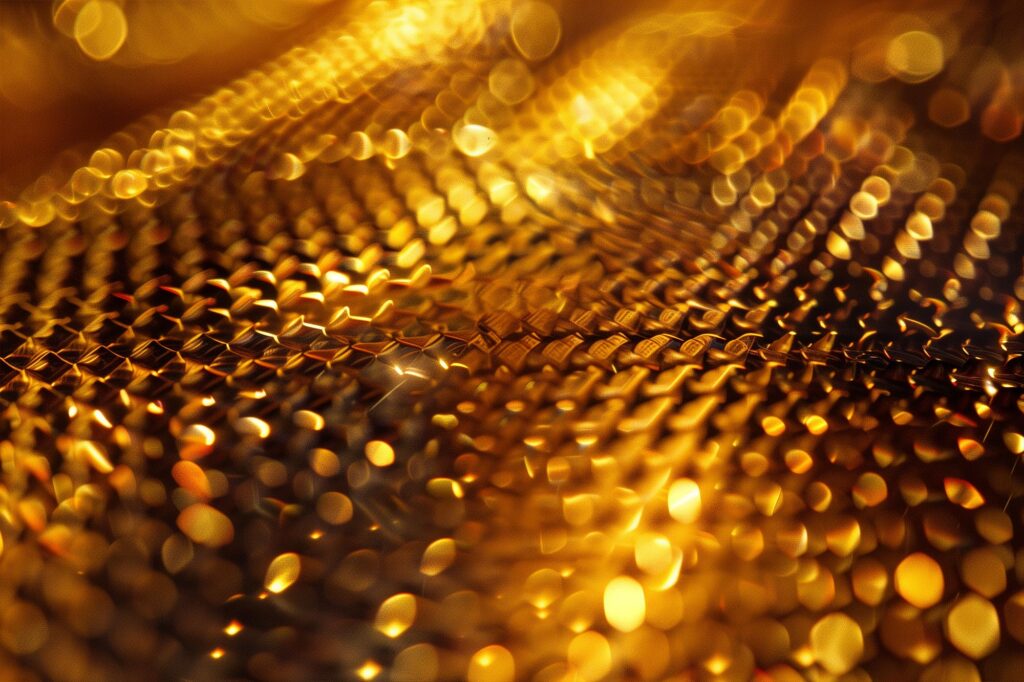New research on thin gold films has uncovered novel photoluminescence behaviors, advancing our understanding of nanoscale chemical reactions and temperature measurement. This breakthrough enhances the use of metals in energy research and offers new methods to probe surface processes crucial for solar fuel development. Credit: SciTechDaily.com
Researchers at EPFL have created the first detailed model explaining the quantum-mechanical effects that cause photoluminescence in thin gold films, a breakthrough that could advance the development of solar fuels and batteries.
Luminescence, the process where substances emit photons when exposed to light, has long been observed in semiconductor materials like silicon. This phenomenon involves electrons at the nanoscale absorbing light and subsequently re-emitting it. Such behavior provides researchers with valuable insights into the properties of semiconductors, making them useful tools for probing electronic processes, such as those in solar cells.
In 1969, scientists discovered that all metals luminesce to some degree, but the intervening years failed to yield a clear understanding of how this occurs. Renewed interest in this light emission, driven by nanoscale temperature mapping and photochemistry applications, has reignited the debate surrounding its origins. But the answer was still unclear – until now.
“We developed very high-quality metal gold films, which put us in a unique position to elucidate this process without the confounding factors of previous experiments,” says Giulia Tagliabue, head of the Laboratory of Nanoscience for Energy Technologies (LNET) in the School of Engineering.
In a recent study published in Light: Science and Applications, Tagliabue and the LNET team focused laser beams at the extremely thin – between 13 and 113 nanometers – gold films, and then analyzed the resulting faint glow. The data generated from their precise experiments was so detailed – and so unexpected – that they collaborated with theoreticians at the Barcelona Institute of Science and Technology, the University of Southern Denmark, and the Rensselaer Polytechnic Institute (USA) to rework and apply quantum mechanical modeling methods.
The researchers’ comprehensive approach allowed them to settle the debate surrounding the type of luminescence emanating from the films – photoluminescence – which is defined by the specific way electrons and their oppositely charged counterparts (holes) behave in response to light. It also allowed them to produce the first complete, fully quantitative model of this phenomenon in gold, which can be applied to any metal.
Unexpected quantum effects
Tagliabue explains that, using a thin film of monocrystalline gold produced with a novel synthesis technique, the team studied the photoluminescence process as they made the metal thinner and thinner. “We observed certain quantum mechanical effects emerging in films of up to about 40 nanometers, which was unexpected, because normally for a metal, you don’t see such effects until you go well below 10 nm,” she says.
These observations provided key spatial information about exactly where the photoluminescence process occurred in the gold, which is a prerequisite for the metal’s use as a probe. Another unexpected outcome of the study was the discovery that the gold’s photoluminescent (Stokes) signal could be used to probe the material’s own surface temperature – a boon for scientists working at the nanoscale.
“For many chemical reactions on the surface of metals, there is a big debate about why and under what conditions these reactions occur. Temperature is a key parameter, but measuring temperature at the nanoscale is extremely difficult, because a thermometer can influence your measurement. So, it’s a huge advantage to be able to probe a material using the material itself as the probe,” Tagliabue says.
A gold standard for solar fuel development
The researchers believe their findings will allow metals to be used to obtain unprecedentedly detailed insights into chemical reactions, especially those involved in energy research. Metals like gold and copper – the LNET’s next research target – can trigger certain key reactions, like the reduction of carbon dioxide (CO2) back into carbon-based products like solar fuels, which store solar energy in chemical bonds.
“To combat climate change, we are going to need technologies to convert CO2 into other useful chemicals one way or another,” says LNET postdoc Alan Bowman, the study’s first author.
“Using metals is one way to do that, but if we don’t have a good understanding of how these reactions happen on their surfaces, then we can’t optimize them. Luminescence offers a new way to understand what is happening in these metals.”
Reference: “Quantum-mechanical effects in photoluminescence from thin crystalline gold films” by Alan R. Bowman, Alvaro Rodríguez Echarri, Fatemeh Kiani, Fadil Iyikanat, Ted V. Tsoulos, Joel D. Cox, Ravishankar Sundararaman, F. Javier García de Abajo and Giulia Tagliabue, 19 April 2024, Light: Science & Applications.
DOI: 10.1038/s41377-024-01408-2


